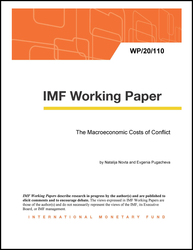
The Macroeconomic Costs of Conflict
The Macroeconomic Costs of Conflict
READ MORE...
Volume/Issue:
Volume 2020
Issue 110
Publication date: June 2020
ISBN: 9781513547756
$18.00
Add to Cart by clicking price of the language and format you'd like to purchase
Available Languages and Formats
| English |
Prices in red indicate formats that are not yet available but are forthcoming.
Topics covered in this book
This title contains information about the following subjects.
Click on a subject if you would like to see other titles with the same subjects.
Economics- Macroeconomics , Public Finance , Demography , WP , number , conflict onset , battle , refugee , log GDP , refugee flow , conflict country , GDP decline , refugee status , number of refugee , country well , refugee dynamics , country size , conflict GDP , country population , asylum country , Public expenditure review , Consumption , GDP forecasting , Private consumption , Global , Middle East , Sub-Saharan Africa , conflict , war , growth , trade , migration , destination country population , IMF country expert
Summary
Macroeconomic costs of conflict are generally very large, with GDP per capita about 28 percent lower ten years after conflict onset. This is overwhelmingly driven by private consumption, which falls by 25 percent ten years after conflict onset. Conflict is also associated with dramatic declines in official trade, with exports (imports) estimated to be 58 (34) percent lower ten years after conflict onset. The onset of conflict often also induces significant refugee outflows to neighboring non-advanced countries in the short run, and relatively small but very persistent refugee outflows to advanced countries over the long run. Finally, we stress that conflict should be defined in terms of the number of people killed relative to the total population. The traditional definition of conflict—based on the absolute number of deaths—skews the sample toward low-intensity conflicts in large countries, thereby understating the negative effects of conflict from a macroeconomic perspective.
Copyright © 2010 - 2025
Powered by:
AIDC



